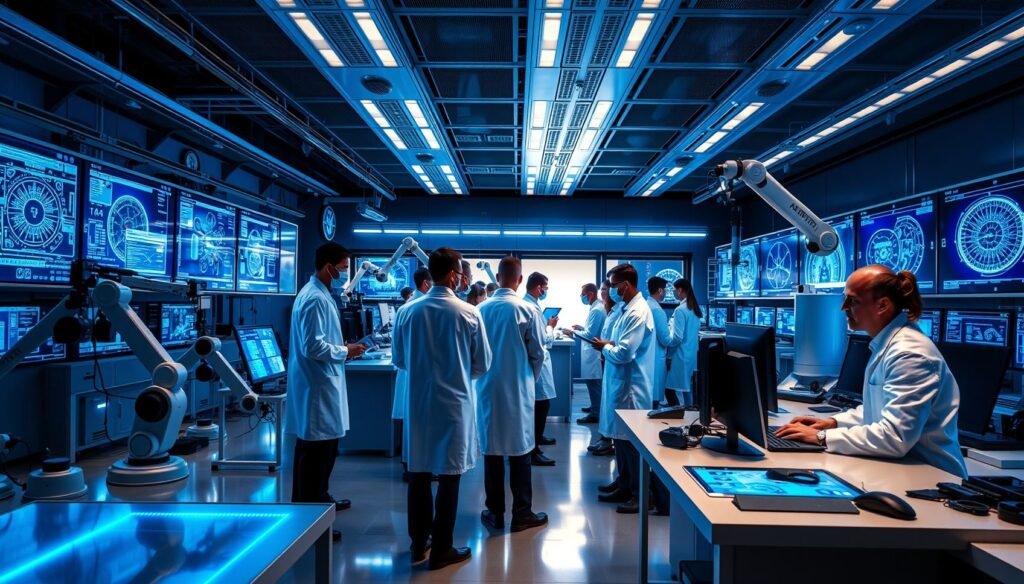Understanding Edge Computing: An Overview of 2025 Trends
Edge computing 2025, a paradigm shift in data processing, is anticipated to play a critical role by 2025. Unlike traditional cloud computing, which relies on centralized data centers, edge computing processes data closer to its source, thus minimizing latency and optimizing bandwidth. This decentralized approach is particularly significant in today’s landscape, where the Internet of Things (IoT) is thriving, and real-time data analysis is paramount.
The core advantage of edge computing lies in its ability to enhance performance and efficiency. In scenarios such as autonomous vehicles, smart cities, and wearable health technology, immediate data processing is crucial for decision-making processes. For example, an autonomous vehicle needs to interpret data from its environment in real time to navigate safely. By leveraging edge AI, devices can analyze data locally and act on it swiftly, reducing reliance on distant server farms. This not only accelerates response times but also cuts down on bandwidth costs associated with sending large volumes of data to the cloud.
As we head towards 2025, we can expect further integration of edge computing into various sectors such as healthcare, agriculture, and manufacturing. For instance, in healthcare, real-time monitoring devices can provide timely insights that lead to better patient outcomes. Similarly, smart agriculture technologies can analyze data on-site to optimize crop yields while reducing resource wastage. Check out our articles on AI applications and AI advancements for additional insights.
The Role of Edge AI in Transforming Data Processing
Edge AI integrates artificial intelligence with edge computing, enabling devices to process data locally rather than relying solely on centralized cloud servers. This approach significantly enhances data processing performance by reducing latency—essential for real-time applications where every millisecond counts. According to a report by Forbes, the shift towards edge AI is catalyzing a transformation in various industries by allowing faster data analysis and decision-making directly at the source.
Comparing Edge AI and Cloud Solutions
When examining edge computing in 2025, it’s crucial to compare its merits against traditional cloud solutions. Cloud computing centralizes data processing, which can lead to delays, especially in environments that require swift response times like autonomous vehicles or factory automation. In contrast, edge AI empowers devices—like drones and smart cameras—to analyze data on-site, leading to a substantial reduction in bandwidth usage and enhanced privacy, as sensitive data does not need to be transmitted to the cloud for processing (McKinsey).
Applications and Use Cases of Edge AI
The application of edge AI is resonating across various sectors. In healthcare, edge devices can monitor patient health metrics in real time, enabling quicker diagnosis and response with no delay. Retail environments benefit as well; smart shelves equipped with edge AI technology can analyze customer preferences instantly, allowing for dynamic inventory management and personalized shopping experiences. Moreover, in IoT edge computing, devices can communicate with each other and process data without the delays associated with cloud computing, further optimizing industry operations (IBM).
The future of edge AI is bright and integral to the evolution of data processing, offering solutions that will be indispensable in the radically connected environments that will be the hallmark of 2025. For more information on how AI tools are evolving, check out our article on top AI tools for solopreneurs.
IoT Edge Computing: Revolutionizing Connectivity and Efficiency
The emergence of IoT edge computing is reshaping the landscape of connectivity and operational efficiency across industries. Unlike traditional centralized cloud computing, which processes data in remote data centers, IoT edge computing brings computations closer to where the data is generated. This shift minimizes latency and optimizes bandwidth use, leading to faster response times and more reliable services.
One of the key advantages of edge computing is its ability to handle vast amounts of data produced by IoT devices without overwhelming cloud infrastructure. Consider a smart city scenario where traffic sensors, surveillance systems, and environmental monitors collaborate to improve urban living. By processing data locally, edge devices can instantly analyze real-time metrics and respond to situations—like rerouting traffic or alerting emergency services—without waiting for cloud processing. These implementations enhance both connectivity and operational efficiency, enabling smarter decision-making.
Comparative Analysis: Edge Computing vs. Cloud Computing
In contrast to cloud computing, which often suffers from latency challenges due to data transmission to and from remote servers, edge computing decentralizes data processing. This architecture significantly improves the speed of data handling and reduces costs associated with bandwidth and storage. A detailed comparison visualizes these efficiencies through diagrams showcasing data flow.
Opportunities Through Use-Case Diagrams
To further illustrate the impact of IoT edge computing, we can analyze specific use-case diagrams. In an industrial setting, sensors on machinery can relay performance metrics to edge devices instantly. These devices can perform diagnostics and trigger maintenance requests without human intervention, reducing downtime and costs significantly. In healthcare, wearable devices can monitor patients in real time and provide immediate alerts to medical professionals, enhancing patient care.
As the trend toward edge AI capabilities grows, we can anticipate even more sophisticated applications by 2025. As edge devices become smarter through AI integration, we will see enhanced predictive analytics that not only assess current conditions but also forecast future scenarios. This ongoing evolution in IoT edge computing redefines possibilities across various sectors, paving the way for improved operational frameworks and better resource management.
Edge Computing by 2025: Key Drivers and Industry Insights
As we approach 2025, the landscape of edge computing is being reshaped by key trends and predictions. One of the primary drivers of this transformation is the increasing integration of Internet of Things (IoT) devices. These devices generate massive amounts of data that require local processing to reduce latency and improve real-time decision-making. According to a report by Gartner, the number of connected IoT devices is expected to reach 25 billion by 2030, highlighting the urgent need for efficient edge AI solutions.
Edge AI is becoming a pivotal aspect of edge computing by enabling data processing closer to the data source, which improves response times. In industries like manufacturing, smart sensors powered by edge AI can analyze data on-site to optimize production processes instantaneously, leading to significant cost savings and enhanced operational efficiency. This shift toward IoT edge computing alleviates the burden on network infrastructures, providing a more resilient system capable of handling fluctuating user demands.
Moreover, performance enhancements and cost efficiencies will shape the competitive landscape. As organizations assess the financial implications of cloud solutions, edge computing often emerges as an attractive alternative. According to Forbes, edge computing can significantly reduce data transfer costs and processing latencies, making it a compelling choice for businesses looking to streamline operations.
Overall, the trajectory of edge computing by 2025 illustrates a move towards faster, more efficient, and cost-effective data processing solutions. The integration of these technologies is expected to transform how data is managed, ultimately impacting numerous industries and everyday experiences. For further insights into AI technologies, check out our guides on AI tools and AI comparisons.
Real-World Applications of Edge Computing: From Theory to Practice
Edge computing has transitioned from theoretical frameworks to practical applications across various industries, showcasing significant advantages over traditional cloud computing. As we approach 2025, numerous case studies demonstrate how edge computing impacts performance metrics, particularly in latency reduction, bandwidth optimization, and enhanced processing capabilities.
Case Studies Highlighting Edge Computing Success
One prominent example of edge computing implementation can be seen in the retail sector. Major retailers like Walmart have integrated edge computing technologies to process customer data such as purchase histories in real-time, allowing for personalized marketing and improved inventory management. Similarly, in healthcare, IoT devices operating at the edge enable healthcare providers to monitor patient vitals instantly, enhancing emergency response times.
Performance Metrics: Edge Computing vs. Cloud Solutions
Comparative analyses reveal that edge computing significantly lowers latency, achieving response times as low as 1 millisecond in certain applications, compared to an average of 100-200 milliseconds with cloud computing. A study conducted by Gartner predicts that 75% of data generated by IoT devices will be processed at the edge, underscoring the technology’s vital role in handling real-time analytics and decision-making.
Visualizing Edge Computing Applications
Diagrams depicting the architecture of edge computing systems can elucidate how data flows from IoT devices to edge nodes and ultimately to cloud services. These visual representations demonstrate the seamless integration of edge computing into existing infrastructures, showcasing how businesses can leverage the technology without discarding current systems. Explore further insights on integrating edge solutions through our articles on AI tools for enhanced productivity and comparing efficient AI tools.
As the landscape of edge computing continues to evolve, the real-world applications and success stories highlight its potential to reshape industries by 2025, making it a critical component of modern technological infrastructures.
Sources
- Forbes – What is Edge Computing and Why is it Important?
- Forbes – How Edge AI is Improving Business Processes
- Forbes – The Top 5 Edge Computing Trends in 2022
- Gartner – Gartner Says Three Emerging Tech Trends Will Continue to Shape the Future of Digital Business
- Gartner – Global Edge Computing Market is Expected to See Massive Growth by 2025
- IBM – What is Edge Computing?
- McKinsey – How the Cloud and Edge Computing are Evolving
- NCBI – Internet of Things Devices in Telemedicine: A Review of Current Trends



